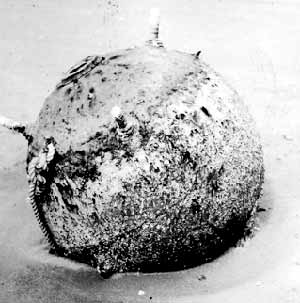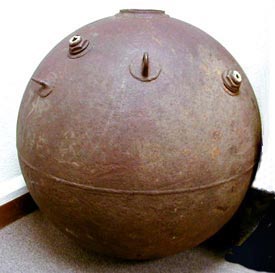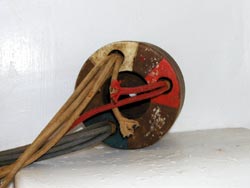Imperial Japanese Naval Mines
Japanese Type 93 Japanese Naval Mine (World War II)

Japanese Type 93 Naval Mine
on beach in Washington
(courtesy Don McArthur)

Type 93 Mine on display
North Lincoln County Historical Museum
Lincoln City, Oregon
Prior to World War II, the Imperial Japanese Navy did not spend much energy on mines. Mines were considered to be an defensive weapon; Japanese Navy doctrine was almost exclusively offensive. Almost all Japanese mines were of Hertz Horn construction – note the horns on the mines above.

Type 93 Detonator Wiring Harness
Each horn contained sulphuric acid. Contact with the horn broke open the acid container which energized a battery and exploded the mine. This wiring harness, taken from a mine that washed ashore near Nesika Beach during the war, shows four brown wires and four blue lead wires that come from four horns, indicating that this is a Type 93 Model 1 mine. The red wires come from the safety switch. This wooden block was mounted on the booster charge.
The Type 93 Model 1 weighed 1,543 pounds (700 kilograms) with 220 pounds of Type 88 high explosive.

Japanese Type 93 Mine Detonator
Once the horn battery sent a signal through the brown/red wire circuit to the wooden block mounted on the detonator, it triggered a booster charge in the mechanism shown above. The Type 88 explosive charge was packed around the booster charge. Type 88 high explosive consisted of 66 percent ammonium perchlorate, 16 percent ferro-silicon, 12 percent wood pulp, and 6 percent oil.
The mine that washed ashore south of Port Orford was disarmed by U.S. Navy explosive ordnance disposal personnel. The detonator and wirng harness were salvaged; the remainder of the mine was destroyed by a controlled detonation. The detonator and harness are on display in the museum.
The Port Orford Heritage Society expresses its appreciation to Tim Flake for providing the mine artifacts and to Don McArthur for technical descriptions.

